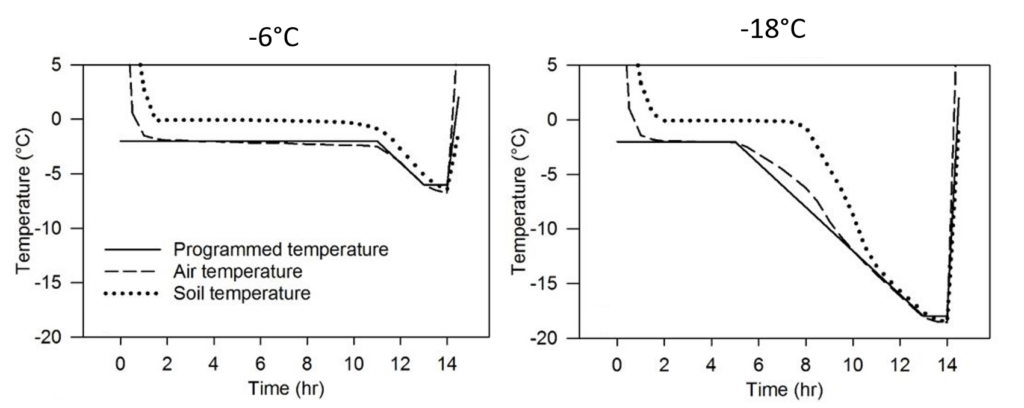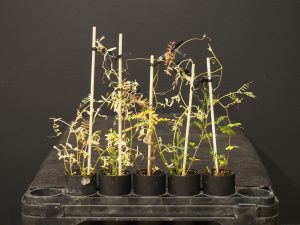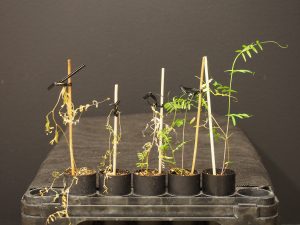Final report for GNC16-232
Project Information
High tunnels are a very popular tool, particularly among organic and sustainable farmers, used to extend the growing season. In addition to a longer growing season, high tunnels also increase both yield and quality of many fruits, vegetables, and flowers. However, high tunnel environments face particular soil health challenges due to a longer, more intensive season, irrigation under dry conditions, and increased heat. Legume cover crops can help address some of these challenges through addition of organic matter and biological nitrogen fixation. For growers in cold climates who do not grow crops in high tunnels through the winter, the late fall-early spring window is a possible time to include cover crops in high tunnel rotations. However, prior field observations found very low survival of cover crops in high tunnels in Minnesota, and high temperature fluctuations were hypothesized as a potential reason.
To address this question, a controlled environment freezing study was designed to evaluate hairy vetch and red clover plants at different freezing temperatures after being exposed to conditions that mimicked high tunnel conditions and those used in conventional freezing studies. The results of this study showed that the high tunnel conditions increased freezing tolerance of both red clover and hairy vetch compared to the conventional cold acclimation conditions. This suggests that temperature fluctuations seen in high tunnels do not reduce freezing tolerance.
- Evaluate freezing tolerance of two common legume cover crops, red clover and hairy vetch, for high tunnel environments
- Assess freezing temperature effect on cover crop biomass and percent nitrogen
- Provide basic information about freezing tolerance of red clover and hairy vetch to farmers who are interested in using these legumes as winter annual cover crops in high tunnels
Cooperators
- (Researcher)
Research
Overview
This freezing tolerance study took place in controlled environments (growth chamber and greenhouse) in St Paul, Minnesota. Hairy vetch (Vicia villosa) and red clover (Trifolium pratense) were grown under different cold acclimation treatments, then exposed to a range of freezing temperatures from -6°C to -18°C. Each combination of plant species, acclimation treatment, and freezing treatment had 30 individual plants. Percent survival and biomass regrowth data were collected 3 weeks after freezing treatments. Hairy vetch biomass was later analyzed for percent tissue nitrogen.
Acclimation treatments
Acclimation treatments were designed to compare standard acclimation treatments used in freezing studies to simulated high tunnel conditions. After 3 weeks of germination in a greenhouse with 25°C days and 10°C nights, plants were moved into one of two acclimation treatments for 3 weeks: standard acclimation or high tunnel simulation.
- Standard acclimation plants were placed in a growth chamber with 2°C days and 2°C nights. After freezing, plants defrosted for 2 days at 2°C, then moved to the greenhouse with 22°C days and nights for 3 weeks of recovery before data collection.
- High tunnel simulation plants were placed in a growth chamber with 20°C days and 2°C nights for 1 week then 20°C days and -2°C nights for 2 weeks, in an attempt to replicate observed high tunnel conditions in fall in Minnesota. After freezing, plants defrosted for 2 days at 2°C, then moved back to the growth chamber with 20°C days and -2°C nights for 3 weeks of recovery before data collection.
See diagram below for summary of environmental conditions.

Freezing treatments
After 3 weeks of germination and 3 weeks of acclimation, plants were subjected to one overnight freezing event. These freezing events had 5 possible minimum temperatures: -6°C, -9°C, -12°C, -15°C, or -18°C. Plants were placed into a freezing chamber at -2°C. Temperature was held at -2°C, then decreased by -2°C per hour until the desired minimum temperature was reached. Temperatures remained at the desired minimum for 1 hour. See figures below for visualization of freezing events with -6°C and -18°C minimums.

Data collection
Data was collected 3 weeks after plants were exposed to freezing events. Plants were scored as living or dead to assess percent survival. Living green biomass was collected by cutting at the crown, dried at 60°C for 72 hours, and weighed. Vetch biomass was ground using a mortar and pestle and analyzed for percent nitrogen using a PYRO cube combustion analyzer (Elementar, Germany).


Survival and LT50
LT50 is the temperature at which 50% of plants die, and it is a convenient measurement to compare freezing tolerance between different plants and treatments. It is calculated by graphing the percent survival of a given treatment over different freezing temperatures, then fitting an S shaped curve to the data and finding the point on the line where 50% of plants died. LT50s cannot predict how well a given plant will tolerate different field conditions, but comparing LT50s can estimate which treatments are relatively more freezing tolerant than others.
Both clover and vetch had lower LT50s when grown under high tunnel simulation compared to standard acclimation, meaning that the plants grown under high tunnel simulation conditions were more freezing tolerant than those grown under standard acclimation conditions. Clover plants grown under standard acclimation had an LT50 of -7.6°C, and clover plants grown under high tunnel simulation had an LT50 of -18.1°C. Vetch plants grown under standard acclimation had an LT50 of -11.3°C, and vetch plants grown under high tunnel simulation had an LT50 of -19.2°C.
This result was the opposite of expected. It was hypothesized that the high tunnel conditions would result in less freezing tolerant plants because a previous field experiment had found 0% survival for winter cover crops in high tunnels in Minnesota. The two hypotheses for total winter-kill in that experiment were stressful temperatures or lack of moisture. This study shows that freezing tolerance for well-watered plants at 6 weeks is not lowered by the high tunnel simulated conditions, indicated that lack of moisture may have been the cause of total winter-kill in the field.
The plants under high tunnel simulation were significantly more cold tolerant than the plants under standard acclimation, suggesting that the high tunnel simulation might provide plants with better cold acclimation. This may be due to a difference in day temperature, night temperature, or a combination of both. The high tunnel simulation conditions could produce more freezing tolerant plants through the colder night temperature, which gave the plants exposure to temperatures slightly below 0°C before the extreme freezing events. Or, the high tunnel simulation conditions could produce more freezing tolerant plants through warmer day temperatures (20°C vs. 2°C), which may have allowed plant to tolerate colder freezing temperatures due to increased photosynthetic rates during the acclimation period.
Biomass regrowth
Biomass regrowth for each plant species/acclimation treatment combination followed the same pattern. Plants frozen at colder freezing temperatures had less biomass regrowth than plants frozen at warmer freezing temperatures. Overall, vetch plants regrew about 10 times as much biomass a clover plants.
Hairy vetch nitrogen content
Vetch tissue nitrogen varied by freezing temperature, but the pattern was different depending on the acclimation treatment. For vetch grown under high tunnel simulation, percent nitrogen increased as freezing temperatures got colder, from 2.96 %N (-6°C) to 4.04 %N (-18°C). For vetch grown under standard acclimation, the trend was reversed with percent nitrogen decreasing as freezing temperatures got colder, from 4.82 %N (-6°C) to 3.15 %N (-12°C). There are no values for standard acclimated vetch frozen at -15°C and -18°C or for any clover treatments because there was not enough plant biomass for analysis.
This opposing trend due to acclimation treatment was unexpected. The pattern seen in the high tunnel simulation plants could be due to the fact that younger plant tissue has higher %N than older tissue, and plants frozen at colder freezing temperatures took more time to initiate new growth. This explains the pattern in the high tunnel simulation plants where colder freezing temperatures resulted in higher percent nitrogen. However, this does not explain the pattern in the standard acclimated plants.
Educational & Outreach Activities
Participation Summary:
Publications and presentations
Perkus, E. 2018. Legume cover crops in high tunnels: Field evaluation for soil health and controlled environment freezing tolerance. Masters Thesis. University of Minnesota.
Perkus, E., Thurston, C., Watkins, E., Heineck, G., and Grossman, J. 2017. Freezing tolerance of two legume cover crops for Upper Midwest high tunnel conditions. Poster presentation. American Society for Horticultural Science Annual Conference, Tampa, FL. 22-25 October. Awarded 3rd place in competition.
Future Use
This work will be presented at SARE/ATTRA Our Farms Our Food conference in St Louis, MO (April 2018) and published in an academic journal. Findings from this study will be included in future Grossman Lab presentations and field days to high tunnel growers.
Project Outcomes
Some farmers are facing soil health related challenged in their high tunnels, and legume cover crops grown over the winter can address some of these problems. High tunnels are expensive to construct and yield high value, high quality produce, so taking production time to grow a cover crop is not an easy decision. One question regarding winter cover crops in high tunnels was whether the high temperature fluctuations from fall through spring were making cover crops more likely to winter-kill than in the open field. This research has shown that, under very specific conditions, both red clover and hairy vetch can tolerate colder single freezing events after being exposed to 20°C day and -2°C night than 2°C day and night. This is not a guarantee that red clover and hairy vetch will survive all winter freezing events, but it does suggest that cover crops with adequate moisture are not more susceptible to winter kill in high tunnels compared to the open field. Farmers who have successfully over-wintered cover crops in their fields can be reasonably confident that irrigated cover crops will survive in their high tunnels.